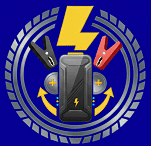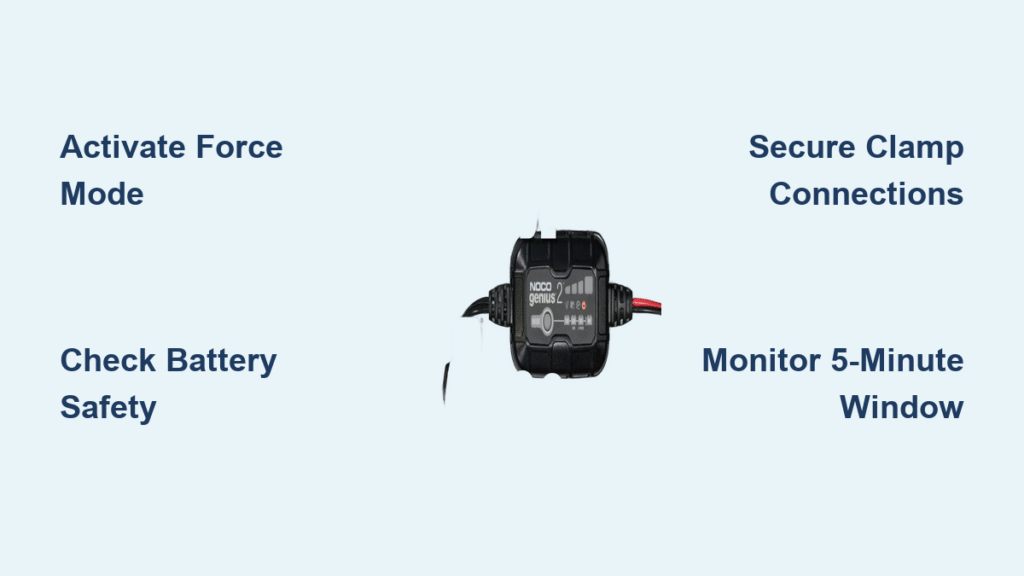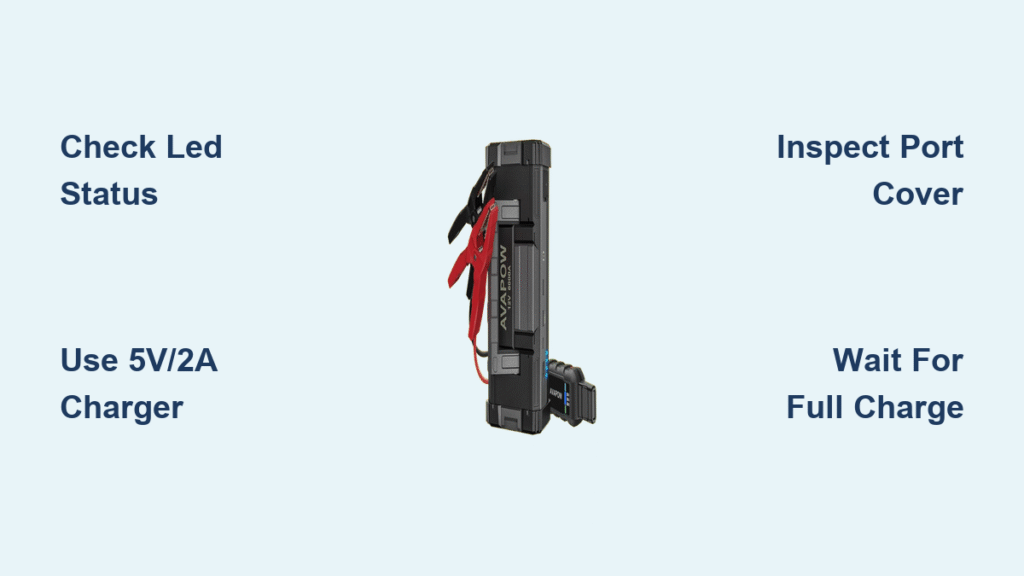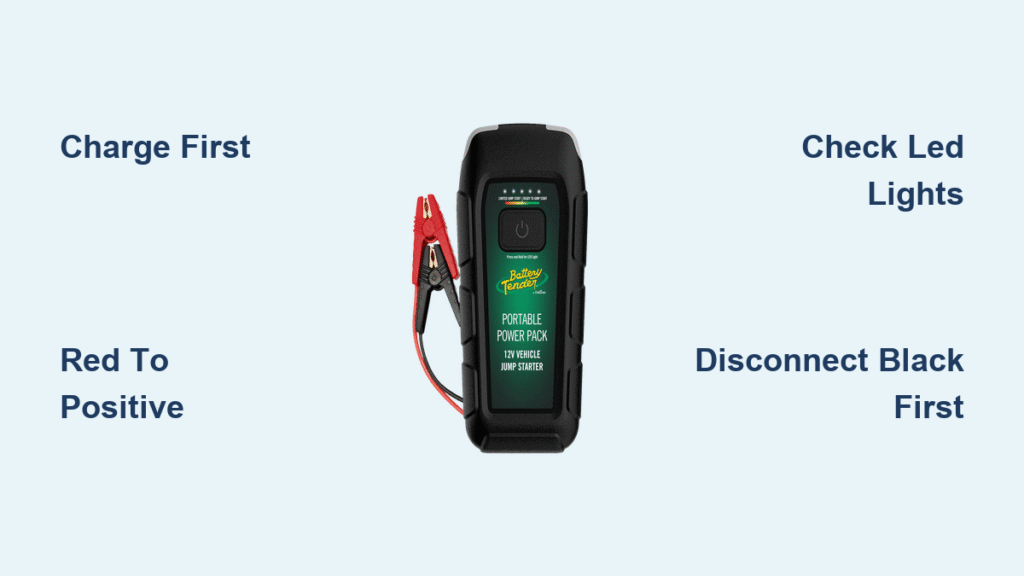Your weekend project van won’t crank after three months in storage. The multimeter reads 0.2 volts on the battery—nowhere near enough to trigger your NOCO GENIUS charger’s standard detection. That “Standby” light mocks you while the battery sits chemically salvageable but electrically invisible. This is exactly where NOCO’s Force Mode becomes your last lifeline. Unlike normal charging that requires at least 1 volt to initiate, Force Mode bypasses all safety thresholds to deliver current to batteries at absolute zero volts. But one wrong connection during those critical five minutes could melt clamps or ignite hydrogen gas. Follow this precise roadmap to resurrect flatlined batteries while avoiding catastrophic mistakes.
Why Your NOCO Charger Won’t Detect a Dead Battery
NOCO GENIUS chargers (including GENIUS10, GENIUS5, and GENIUS2 models) intentionally refuse to charge batteries below 1 volt during standard operation. This isn’t a limitation—it’s a critical safety feature preventing dangerous charging attempts on shorted or internally damaged cells. When parasitic drains from alarm systems or forgotten dome lights drop voltage to 0.5 volts or lower, the charger correctly assumes the battery is either dead or unsafe. Yet many lead-acid batteries can recover from 0-volt states if sulfation hasn’t permanently damaged the plates. Force Mode exists specifically for these borderline cases where a battery appears dead but retains chemical viability.
Critical Safety Risks When Bypassing Protections
Force Mode disables every built-in safety net simultaneously. Your charger normally blocks current flow if it detects reversed clamps, short circuits, or excessive heat. During Force Mode’s five-minute cycle, none of these safeguards function. A single reversed clamp connection will force current backward through your battery, potentially causing:
- Explosive hydrogen gas ignition from reverse-charging
- Permanent damage to the charger’s internal circuitry
- Battery case rupture from rapid gassing
Lithium batteries below 2 volts present even greater hazards—internal copper shunts can form during deep discharge, making them prone to thermal runaway when current is reapplied. If you smell rotten eggs (sulfur) or feel abnormal heat within 60 seconds of activation, disconnect immediately. Your physical presence during the entire cycle isn’t optional—it’s your only protection.
How to Activate Force Mode on Any NOCO GENIUS Charger

Verify Battery Safety Before Connecting
Inspect the battery for visible damage: cracks, acid leaks, or case swelling indicate internal failure. Never attempt Force Mode on swollen or leaking batteries—these require professional disposal. For flooded lead-acid types, check electrolyte levels; dry plates won’t recover. Position the battery outdoors or in a well-ventilated garage away from sparks or flames. Hydrogen gas accumulation during charging can trigger explosions in enclosed spaces.
Connect Clamps With Military-Grade Precision
- Attach the red clamp firmly to the battery’s positive terminal (marked “+”)
- Secure the black clamp to the negative terminal (marked “-“)
- Wiggle both clamps vigorously—you need bare-metal contact, not paint or corrosion
- Confirm no clamp jaws touch adjacent metal surfaces
A loose connection creates resistance points that generate intense heat during Force Mode. I’ve seen melted clamp handles within 90 seconds from seemingly “secure” but corroded terminals. Your multimeter should show 0 volts before proceeding—any higher means standard charging might work.
Execute the Exact 7-Second Button Sequence
Press and hold the Mode button for precisely 7 seconds. Watch for all mode LEDs to begin flashing uniformly—this confirms entry into selection mode. Release too early (before 5 seconds), and you’ll only toggle between normal modes. Hold beyond 10 seconds, and the charger resets the sequence. Once flashing begins:
- Tap the Mode button once per second
- Stop when only the Force Mode LED flashes (GENIUS10 shows this as the far-right indicator)
- Confirm activation by the distinctive chasing LED pattern across the charge-status lights
This sequence works identically across GENIUS2, GENIUS5, and GENIUS10 models—only button placement differs. Consult your manual if your model uses dual-mode buttons.
What to Monitor During the 5-Minute Critical Window

Set a visible timer the moment Force Mode activates. Stay within arm’s reach for the full duration, watching for these life-saving indicators:
| Sign | Successful Recovery | Danger/Failure |
|---|---|---|
| LED Pattern | Chasing lights slow gradually | Pattern remains rapid/stops |
| Battery Voltage | Rises above 0.5V within 90s | No change after 3 minutes |
| Physical Signs | Mild warmth at terminals | Swelling, boiling, or sulfur smell |
| Post-5-Minute Status | Charger auto-switches to normal mode | Returns to Standby (no lights) |
If voltage climbs above 1 volt within four minutes, the charger automatically re-engages all safety protections and begins standard charging. This is your signal to select the correct chemistry mode (AGM, Flooded, etc.) via the Mode button. If the charger reverts to Standby after five minutes, the battery is irrecoverable—do not attempt Force Mode again.
Why Force Mode Fails on Lithium Batteries Below 2 Volts
Never use Force Mode on lithium (LiFePO4) batteries reading below 2 volts. Unlike lead-acid cells, deeply discharged lithium batteries develop internal copper shunts that create short circuits. Force Mode’s unregulated current delivery can cause:
- Instant thermal runaway (temperatures exceeding 500°F)
- Venting of toxic fumes
- Fire within seconds of activation
Lithium batteries require specialized recovery protocols with voltage ramping below 2.5 volts—something NOCO chargers don’t provide in Force Mode. If your lithium battery reads under 2 volts, replace it immediately. The $150 cost beats risking your garage.
3 Costly Mistakes That Cause Force Mode Disasters

Skipping the physical inspection turns routine recovery into a hazard. A hairline crack in the case becomes a projectile when gassing intensifies during charging. One technician I know triggered an acid spray incident by charging a visibly bulging AGM battery—always walk away from damaged units.
Assuming all “0V” readings mean recovery is possible ignores internal shorts. If your multimeter shows voltage rising when disconnected (e.g., 0.1V → 0.3V after 10 minutes), the battery has a dead cell and won’t hold charge. Force Mode wastes time and creates risks here.
Restarting Force Mode repeatedly after failure seems logical but is deadly. Each five-minute cycle heats the battery further, accelerating sulfation and gas production. After one failed attempt, the battery is either recoverable through standard charging or requires replacement—no exceptions.
Maximizing Success With Battery-Type-Specific Tactics
Flooded Lead-Acid Batteries
Remove cell caps before starting Force Mode. You should see gentle bubbling within 90 seconds if recovery is working. Top up with distilled water if plates are exposed—dry cells won’t accept charge. These have the highest recovery rate (70%+) if voltage climbs within the first two minutes.
AGM and Gel Batteries
Check for case swelling first—AGM batteries rarely recover from true 0-volt states. If voltage rises above 1 volt during Force Mode but the charger won’t auto-resume, manually select AGM mode immediately. Success rates drop below 30% if the battery sat discharged longer than 30 days.
Lithium Iron Phosphate (Rare Cases)
Only attempt if voltage reads between 2.0V and 2.5V. Immediately switch to Lithium mode after Force Mode completes—the charger must apply the correct 14.6V absorption profile. Never exceed 5 minutes, and stop at the first sign of warmth.
Preventing Future Deep Discharge Without Force Mode
Install a $12 battery disconnect switch on seasonal vehicles—this breaks the negative cable connection, eliminating parasitic drain. For motorcycles or boats in storage, use a NOCO Genius Micro 1.0 as a maintenance charger ($35). It delivers 0.8 amps only when voltage drops below 12.6V, preventing deep discharge while avoiding overcharge. Test stored batteries monthly with a multimeter; anything below 12.4V needs a refresh charge.
Force Mode isn’t a magic fix—it’s a controlled emergency procedure with defined limits. When executed correctly on viable batteries, it recovers units standard charging would condemn. But respect the five-minute window, honor the disabled safety systems, and know when to walk away. If your charger returns to Standby after the cycle, that battery has served its final duty. Recycling it costs less than risking your workshop or truck. For confirmed recoveries, complete a full 24-hour charge cycle to dissolve sulfation and restore maximum capacity.





